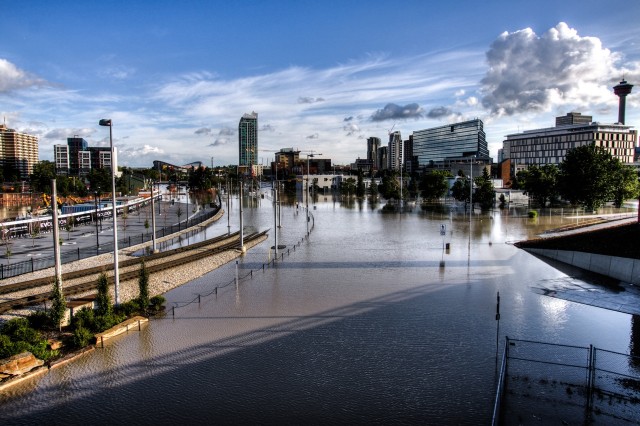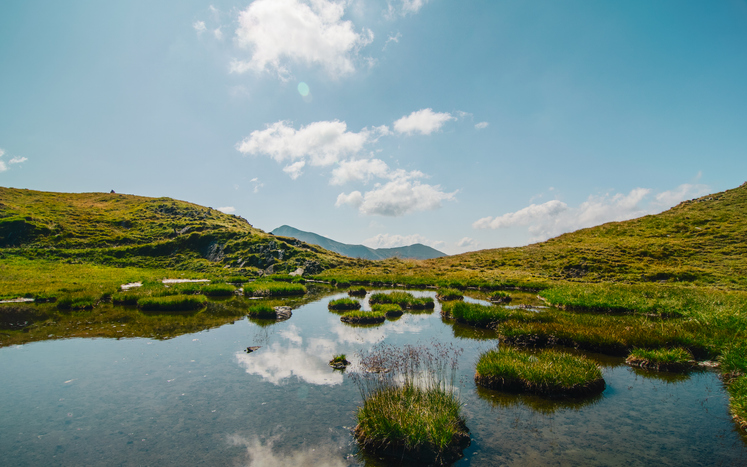The Smart Prosperity Institute has released a report entitled New Solutions for Sustainable Stormwater Management in Canada. The report acts as a primer for municipalities in Canada on best practices in modernizing their stormwater infrastructure and taxation.
The report aims to provide details on an integrated approach to managing stormwater in urban spaces. Specifically, the report takes aim at current mechanisms for handling stormwater: “The current funding mechanisms in place are flawed, and the traditional infrastructure system is not cost-effective and contributes to a number of urban stormwater pollution and flooding problems.”
Two primary recommendations come from the report: move to a dedicated stormwater fee and implement widespread green infrastructure.
A breakdown of the essential recommendations from the report follow.
Benefits of a stormwater user fee:
- Dedicated Revenue Stream—The money is not pooled and used to fund other government services.
- Greater Awareness & Transparency—Provides a precise dollar value to the property owners stormwater usage; is not buried in other water costs.
- Fair Assignment of Costs—not based on property value or water consumption, which are unrelated to stormwater generation on the property.
- Economic Incentive—Possible incentive for consumers to lower stormwater runoff generated to reduce costs, reduces system load, reduces waste, adds value.
Local government challenges to implementation:
- Public Perception—Could be mistakenly perceived as a new charge or tax. Early and clear public consultation can address the challenge.
- User fee design—Proper design of the fee to maximize benefits must be the guiding principle, but will have to be balanced with local government capacity to implement the fee.
- Cost shifts between stakeholders—If the fee is transferred from residential to non-residential users, it could generate much higher billing. This can be addressed by phasing in the program.
Municipalities can improve residential and business implementation of green infrastructure by offering incentives for their implementation on private land. Successful financing models cited in the report include:
- Incentives for green infrastructure
- Credit/discount programs
- Rebates
- Stormwater credit trading
- Development cost charges
- Public-private partnerships
The report was based on analyzing six case studies in Philadelphia, PA, Mississauga, Ont., Victoria, B.C., Kitchener, Ont., Washington, D.C., and Prince George’s County, M.D.. The report concludes by outlining the implications of implementing stormwater management programs, including the fee and green infrastructure.
- User fees can put stormwater funding on a more financially stable footing.
- A combination of user fees with green infrastructure can provide an integrated approach for better urban stormwater management.
- Approaches should be community specific.
- The private sector can be an important partner.
For more, the executive report or the report in full can be viewed on this page.










Am interested getting articles on building green infrastructure gardens to collect and use flood water from my sump pump. Want to know what early plants support this and learn what details I need to prepare for next springs run off. I have underground water that is coming through the sump pump and want to use this water creatively and with purpose.Do you know of anyone in the Peterborough Ontario area who is knowledgeable in designing such a plan.
thank you,
Leah Jacob
Hi Leah,
Great to hear from you. Thanks for your comment and question.
One of the best resources for learning about how to manage water in your local area is a conservation authority in your area. In the case of Peterborough, you can contact Otonabee Conservation.
It’s fantastic that you’re looking to better manage water resource on your property; it will benefit you and the environment! Good luck with your project.
Best,
WC team
Am interested getting articles on building green infrastructure gardens to collect and use flood water from my sump pump. Want to know what early plants support this and learn what details I need to prepare for next springs run off. I have underground water that is coming through the sump pump and want to use this water creatively and with purpose.Do you know of anyone in the Peterborough Ontario area who is knowledgeable in designing such a plan.
thank you,
Leah Jacob
Hi Leah,
Great to hear from you. Thanks for your comment and question.
One of the best resources for learning about how to manage water in your local area is a conservation authority in your area. In the case of Peterborough, you can contact Otonabee Conservation.
It’s fantastic that you’re looking to better manage water resource on your property; it will benefit you and the environment! Good luck with your project.
Best,
WC team
Thank you so much for your direct response. I was just floating around on this question….. an expert told me talk to an expert????? This is an entirely different context than I am familiar with. I have lived in the woods without electricity but this kind of issue in a town is brand new. Do you have any idea what % of houses have water running under them some part of the year in Peterborough?
Thank you so much for your direct response. I was just floating around on this question….. an expert told me talk to an expert????? This is an entirely different context than I am familiar with. I have lived in the woods without electricity but this kind of issue in a town is brand new. Do you have any idea what % of houses have water running under them some part of the year in Peterborough?
Re the above article that focuses on fees, as house owners we are already paying taxes and additional costs for sitting on a wet piece of land, includig hydro for dehydration and for sump pump hydro costs. I spent 2 months with my sump pump gushing out water every 4 minutes. This is scary as well, so being penalized for this surprise at the end of a purchase makes one think and question. I would greatly like to be able to visualize how to extend my side garden where the water may need to go, what plants to use etc. It could be a creative as well as beautiful project once I get my head around it.
We’re happy to help, Leah!
There are many people out there looking for low-cost solutions to managing water on their property. There are definite solutions out there, and we’re sure you’ll find them. It’s all about knowing where to look.
It can be a struggle to manage at first, but the upside is that your cheapest solution in the long-term, will also be the best solution for keeping our shared water resources clean. And make sure to share your solutions with friends and neighbours. We can all work together to improve the quality of our shared water resources.
🙂
Re the above article that focuses on fees, as house owners we are already paying taxes and additional costs for sitting on a wet piece of land, includig hydro for dehydration and for sump pump hydro costs. I spent 2 months with my sump pump gushing out water every 4 minutes. This is scary as well, so being penalized for this surprise at the end of a purchase makes one think and question. I would greatly like to be able to visualize how to extend my side garden where the water may need to go, what plants to use etc. It could be a creative as well as beautiful project once I get my head around it.
We’re happy to help, Leah!
There are many people out there looking for low-cost solutions to managing water on their property. There are definite solutions out there, and we’re sure you’ll find them. It’s all about knowing where to look.
It can be a struggle to manage at first, but the upside is that your cheapest solution in the long-term, will also be the best solution for keeping our shared water resources clean. And make sure to share your solutions with friends and neighbours. We can all work together to improve the quality of our shared water resources.
🙂